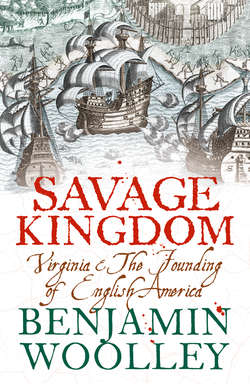Читать книгу Savage Kingdom: Virginia and The Founding of English America - Benjamin Woolley - Страница 14
NINE True Relations
ОглавлениеNEWPORT’S ‘GOOD TALL SHIP’ the John & Francis arrived at Jamestown on 2 January 1608. The crossing had taken three months, a stop at Dominica providing a chance to supplement the stores brought from England with a variety of more exotic goods, such as potatoes, bananas and pineapple, plus some parrots, to entertain the settlers, if not to feed them. Though the arrival of so many more mouths to feed must have aroused some apprehension, the belated fulfilment of Newport’s promise to return was met with relief and delight, spoiled only by the news that the consort vessel the Phoenix, under the mastership of Captain Francis Nelson, had gone missing in fog just 30 or so miles from the mouth of the Chesapeake.1
As soon as he was ashore, the admiral set about re-establishing his authority. As well as halting Smith’s execution, he released Wingfield from the pinnace, and stopped Archer calling a ‘parliament’, an assembly of all the settlers, which he may have tried to summon in a final attempt to overthrow Smith. Newport confirmed Smith’s membership of the council, but stripped him of the office of cape merchant, that job being given to one of the new arrivals, John Taverner. Smith no doubt resented the demotion, not least because it weakened his claim to being in charge of relations with the Indians.
Another newcomer, Matthew Scrivener, ‘a very wise, understanding gentleman’, was sworn in as a new councillor. John Martin was put in charge of recovering the correct sample of gold-bearing earth to take back to England. Percy, meanwhile, remained on the sidelines. Despite the council’s lack of numbers, he was still discounted from office.2
Newport also took swift steps to improve the lot of the long-suffering settlers. He commanded his crew to set about building a ‘fair storehouse’ for the bounties brought from England, a ‘stove’ or warm room to provide respite from the cold, and a proper church, no doubt to the delight of the neglected chaplain Hunt.
The relief was short-lived. On 7 January, a fire swept through the fort, which destroyed all but three of the existing buildings, together with the palisades, ammunition, clothes, food supplies and Preacher Hunt’s library of books. One of the new settlers, Francis Perkins, ‘gentleman’, who had arrived with his son, also Francis, ‘labourer’, was distraught to discover that all their possessions had perished, except for a mattress, which had yet to be unloaded from the ship. Meanwhile, President Ratcliffe was badly hurt in a shooting accident, his pistol blowing up as he attempted to fire it. It ‘split his hand’, leaving him with injuries that would take months to heal.3
After such a setback, the settlers needed a distraction from their woes, and Smith readily supplied it, by telling them the extraordinary ‘relation’ of his capture by the Indians, and his meeting with the great Powhatan. It was a story that only he could tell. But it would revive their ‘dead spirits’, he promised, as well as capture imaginations for generations to come.
Captain Smith’s Relation of his being Taken Prisoner by the Indians, how they Conjured Him, Powhatan entertained Him, would have slain him, and how his daughter saved his life
